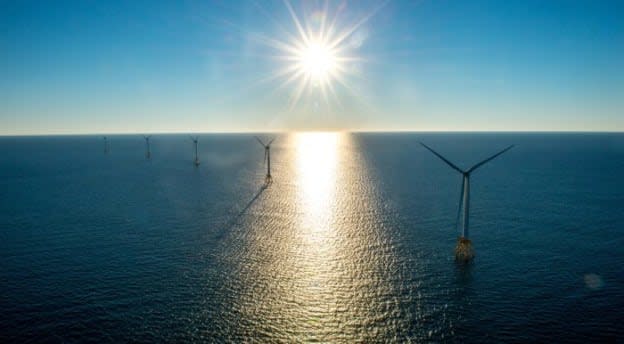New York Moves to Resurrect Two Major Offshore Wind Projects

New York officials put forth conditional contracts to buy electricity from two proposed offshore wind farms, announcing the awards Feb. 29 for installations that would be the largest power generation projects built in the state in decades. The solicitation by the New York State Energy Research and Development Authority (NYSERDA), which allowed developers to exit old contracts in favor of new, more economically-friendly deals, resulted in contracts for the Empire Wind 1 project from Norway's Equinor, and the Sunrise Wind installation being built by Denmark's Orsted and U.S. utility Eversource. The NYSERDA program is designed to support New York's offshore wind industry, and provide more impetus for the state's clean energy targets. New York has a goal to develop 9,000 megawatts of offshore wind generation capacity by 2035. Sunrise Wind (924 MW) and Empire Wind 1 (810 MW) will contribute more than 1,700 MW toward that target. The wind farms are expected to come online in 2026 and 2027, respectively.
Offshore Wind 'Foundational'
"I promised to make New York a place for the renewable energy industry to do business, and we are delivering on that promise," New York Gov. Kathy Hochul said in a statement. "Offshore wind is foundational to our fight against climate change, and these awards demonstrate our national leadership to advance a zero-emissions electric grid at the best value to New Yorkers." The projects can now enter into contracts to sell Offshore Wind Renewable Energy Certificates (ORECs) to NYSERDA on behalf of New York electricity customers. Both projects are in the final stages of the federal government permitting process. The U.S. to date has installed more than 240 MW of offshore wind generation capacity off the coasts of New York, Massachusetts, Rhode Island, and Virginia, according to government data. That's up from 42 MW at this time last year. Developers of U.S. offshore wind projects, along with some of their global counterparts, have said the industry is facing challenges from higher construction costs, along with issues caused by increased interest rates for financing. Supply chain issues also continue to weigh on some projects. Offshore wind developers traditionally sign long-term agreements, detailing the rate customers will pay for electricity and how much they will use, early in the process of designing a wind farm. The lack of flexibility in those contracts meant the developers would be on the hook for rising costs. That led developers last year to cancel contracts to sell 5.5 GW of offshore wind energy along the coast of the U.S. Northeast. Equinor and Orsted each have said the economics of their U.S. offshore wind projects are being challenged, and both groups wanted to charge customers more for the electricity from their installations. New York officials did not agree to that plan, but did say companies could rebid projects to perhaps improve the economic outlook. The companies on Thursday said they will now negotiate final terms for 25-year contracts. Each group said the deals are expected to be executed by mid-year. Orsted late last year said it would stop development of two offshore wind farm projects off the coast of New Jersey due to rising costs. The company at the time said that ending the Ocean Wind 1 and 2 projects, with combined generation capacity of 2,248 MW, could result in more than $5 billion in impairment charges.
'New Beginning'
"This is a promising new beginning for Empire Wind 1 and we're ready to get started," Equinor Renewables America President Molly Morris said in a statement. Equinor's project proposal includes remaking a marine terminal in Brooklyn into a staging and port facility for offshore wind development. "We applaud the Hochul administration for their steadfast support of clean, renewable offshore wind power. These awards for the Sunrise Wind and Empire Wind 1 projects demonstrate the state's commitment to offshore wind and diversify its energy portfolio, representing a significant step forward to building a sustainable energy future for generations to come," said Anne Reynolds, vice president for Offshore Wind at the American Clean Power Association, in a statement emailed to POWER. "By investing in and advancing offshore wind development, New York is paving the way for other states and regions to follow suit, enabling a nationwide shift toward a low-carbon future that will create jobs, revitalize ports, and enhance grid reliability." Orsted previously had said it would acquire Eversource's 50% stake in the Sunrise Wind project, though Eversource still would direct the wind farm's onshore construction. The utility in a statement said, "Upon the completion of a successful sale, Eversource no longer expects to have any risk exposure related to Sunrise Wind, including abandonment costs that were assumed in its impairment assessment." Sunrise Wind is expected to be the largest U.S. offshore wind project once complete, based on current U.S. installation announced timelines. Equinor and BP earlier this year said they would end the groups' 1,260-MW Empire Wind 2 project, citing "commercial conditions driven by inflation, interest rates and supply chain disruptions." Equinor on Thursday said the company "intends to bring in a partner to enhance value and reduce ownership share and exposure" in Empire Wind 1. Including Empire Wind 1 and Sunrise Wind, there are six U.S. offshore wind projects either under construction or nearing construction. The others are: South Fork Wind off New York (132 MW); Vineyard Wind off Massachusetts (800 MW); Revolution Wind off Connecticut and Rhode Island (714 MW); and Coastal Virginia Offshore Wind off Virginia (2,500 MW), which is scheduled for monopile installation by mid-year. —Darrell Proctor is a senior associate editor for POWER (@POWERmagazine).
